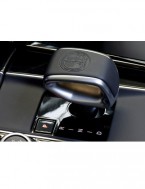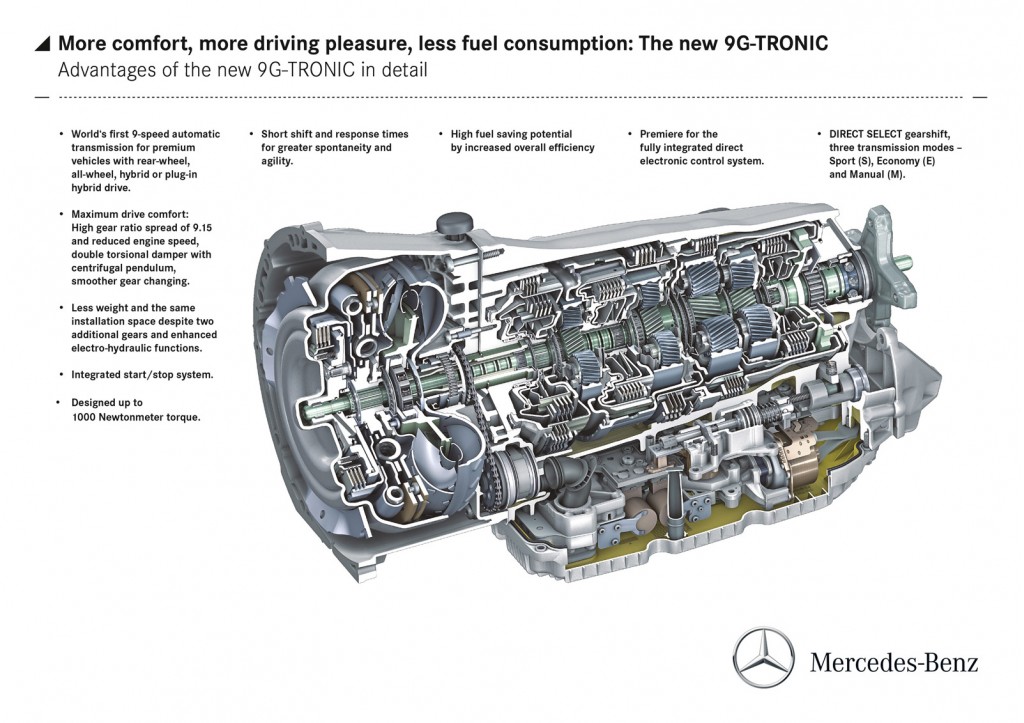
Last year, Mercedes-Benz debuted its 9 speed transmission (called 9G-Tronic) in its European market E class sedan.
Although with the same aluminum made torque converter bell housing, compared to the current 7G-Tronic, this 9G-Tronic transmission changes to use magnesium alloy to construct its main casing, which is lighter and retains the same strength. The transmission oil pan is made with plastic though.
However, there is no dramatic difference of the mechanical shifting parts between the 9G and 7G transmission. Both of them have 4 planetary gear sets and 6 shifting elements (3 multi-disc clutches and 3 multi-disc brakes). Yes you hear me right, the 7G transmission theoretically can provide the same 9 notches of gear ratio, but for some reasons Mercedes decided not to enable (or, implement) the extra 2 gears in the 7G-Tronic.
Note: some articles say less gear sets and shifting elements are better, for example one online article says “Another goal was to implement the nine gears with the lowest number of planetary gear sets and shift elements as possible“, this is completely not true. Numbers of gear sets and shifting elements do not tell the whole story, it is the transmission efficiency that rules. For example, an internal research done by ZF shows that, even though the “4 gear sets + 5 shifting elements” and “3 gear sets + 6 shifting elements” can both implement the 8 gear ratios, but the “4 gear sets + 5 shifting elements” combination has a much higher transmission efficiency. This is the reason why the current ZF 8HP is using the 4+5 design.
The 9G-Tronic transmission has also incorporated the engine stop-start feature, by introducing a dual transmission fluid pump system. The main pump is chain-driven, and the second electric auxiliary pump will only kick-in when there are large workload which requires extra lubrication and cooling, or the engine is temporarily stopped while waiting at the red traffic light.
When equipped with the 9 speed transmission, according to Mercedes if you are cruising on highway at 75mph, the engine will be revving in a shockingly low 1,350rpm; fuel consumption is thus lowered by 4% too.
The new transmission’s noise level will be 4dB quieter than the 7G one.
Since the wide gear ratio will cause the engine to work in low rpm range more frequently, which leads to greater torque fluctuation, so extra damping is required in the torque converter. Besides the twin turbine torsion damper, Mercedes also put in the centrifugal pendulum technology. All these will improve the comfort of driving under low engine rpm, decrease the slip in the torque converter lockup clutch. The 9G-Tronic torque converter has increased its operating efficiency to 92%, while the 7G only has 85%.
The 9G-Tronic’s competitor: ZF 8HP transmission, has 4 planetary gear sets and 5 shifting elements; and ZF’s latest 9 speed transmission (9HP) is similar to Mercedes’ 9G-Tronic, which also has the same amount of planetary gear sets and shifting elements.




Recent Comments